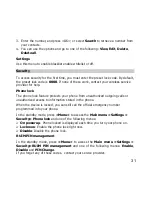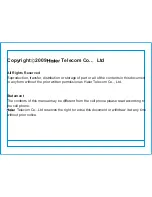
45
z
Battery charging time depends on the remaining battery charge, the type of
battery, and the charger used. The battery can be charged and discharged hundreds
of times, but it will gradually wear out. When the operation time is noticeably shorter
than normal, it is time to buy a new battery.
z
If left unused, a fully charged battery will discharge itself over time.
z
Extreme temperatures will affect the charging capacity of your battery: it may
require cooling or warming first.
z
Do not leave the battery in hot or cold places because the capacity and lifetime of
the battery will be reduced. Try to keep the battery at room temperature. A phone
with a hot or cold battery may not work temporarily, even when the battery is fully
charged. Li-ion batteries are particularly affected by temperatures below 0°C (32°F).
z
Use only approved batteries and chargers. Disconnect the charger from the power
source when it is not in use. Do not leave the battery connected to a charger for more
than a week, since overcharging may shorten its lift.
RF Exposure Information and Statement
The SAR limit of USA (FCC) is 1.6 W/kg averaged over one gram of tissue. Device
types CG100 (FCC ID: UJQ-11855T) has also been tested against this SAR limit.
The highest SAR value reported under this standard during product certification
for use at the ear is 0.
702 W/kg and when properly worn on the body is 0.063
W/kg. This device was tested for typical body-worn operations with the back of
the handset kept 1.5cm from the body. To maintain compliance with FCC RF
exposure requirements, use accessories that maintain a 1.5cm separation
distance between the user's body and the back of the handset. The use of belt
clips, holsters and similar accessories should not contain metallic components in
its assembly. The use of accessories that do not satisfy these requirements may
not comply with FCC RF exposure requirements, and should be avoided.
Содержание CG 100
Страница 1: ...User manual for CG 100 ...
Страница 10: ...6 Mobile phone appearance ...


































